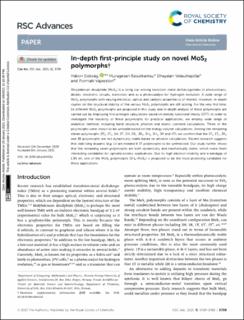| dc.identifier.citation | Eidsvåg, H., Rasukkannu, M., Velauthapillai, D., & Vajeeston, P. (2021). In-depth first-principle study on novel MoS2 polymorphs. RSC Advances, 11(6), 3759-3769. | en_US |
| dc.description.abstract | Molybdenum disulphide (MoS2) is a rising star among transition-metal dichalcogenides in photovoltaics, diodes, electronic circuits, transistors and as a photocatalyst for hydrogen evolution. A wide range of MoS2 polymorphs with varying electrical, optical and catalytic properties is of interest. However, in-depth studies on the structural stability of the various MoS2 polymorphs are still lacking. For the very first time, 14 different MoS2 polymorphs are proposed in this study and in-depth analysis of these polymorphs are carried out by employing first-principle calculations based on density functional theory (DFT). In order to investigate the feasibility of these polymorphs for practical applications, we employ wide range of analytical methods including band structure, phonon and elastic constant calculations. Three of the polymorphs were shown to be unstable based on the energy volume calculations. Among the remaining eleven polymorphs (1T1, 1T2, 1H, 2T, 2H, 2R1, 2R2, 3Ha, 3Hb, 3R and 4T), we confirm that the 1T1, 1T2, 2R2 and 3R polymorphs are not dynamically stable based on phonon calculations. Recent research suggests that stabilising dopants (e.g. Li) are needed if 1T polymorphs to be synthesised. Our study further shows that the remaining seven polymorphs are both dynamically and mechanically stable, which make them interesting candidates for optoelectronics applications. Due to high electron mobility and a bandgap of 1.95 eV, one of the MoS2 polymorphs (3Hb-MoS2) is proposed to be the most promising candidate for these applications. | en_US |

